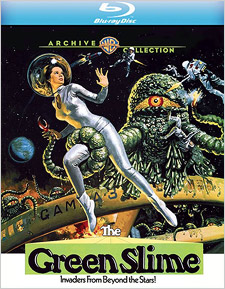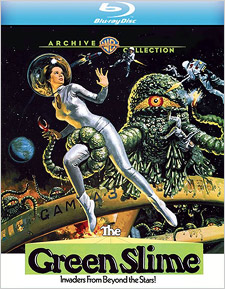Green Slime, The (Blu-ray Review)

Director
Kinji FukasakuRelease Date(s)
1968 (October 10, 2017)Studio(s)
MGM/Warner Bros. (Warner Archive Collection)- Film/Program Grade: D
- Video Grade: A-
- Audio Grade: B
- Extras Grade: D-
Review
Made in Japan with American actors and distributed by an American studio, The Green Slime is anything if not an unusual sci-fi film. It’s certainly one that, while not unique, attempts to mix a militaristic and technical viewpoint with a schlocky monster movie (and a love triangle tossed in for good measure). Released in 1968 by MGM and directed by future Battles Without Honor and Humanity series director Kinji Fukasaku, this unremarkable tale about a group of astronauts who unintentionally bring back an alien lifeform with them from an approaching asteroid and winding up fighting for their survival mostly pleases fans of scale models, old school special effects, rigid story structure, and “so bad they’re good” movies (in no particular order).
The Green Slime accomplishes very little in the scheme of things. This was actually my third viewing of the film in the last couple of years and I could hardly remember anything about it other than its infectiously catchy but inappropriately-placed theme song. There are long stretches of events unfolding that are almost wooden, as if we’re watching the puppets from Thunderbirds Are Go (which would have been more enjoyable by comparison). The poor dialogue being delivered via obvious overdubbing doesn’t do the film any favors either. However, there’s a charm to the moments featuring low grade special effects, but sadly, there just aren’t enough of them. Instead, we’re stuck with Robert Horton, Richard Jaeckel, and Luciana Paluzzi as our leads, arguing often and frequently over the command of the ship and the vapid pretty girl in between them. Mix that with a stale stowaway alien plot and you’ve got a yawner of a movie on your hands.
Thankfully, the good folks at Warner Archive were not induced to sleep while working on the transfer for the film’s Blu-ray release. A crisp, new scan of the film’s interpositive element has been carried out, yielding a much stronger presentation than its DVD-R counterpart. This is the full length 90-minute American version of the film as well, not the 77-minute trimmed-down version. The transfer is quite strong, generating a film-like presentation with potent but evenly-layered grain containing excellent levels of fine detail. Both Horton’s and Jaeckel’s tanned, glycerin-soaked pores are on full display and the low-tech nature of the special effects are now more apparent than ever, which could be a good thing or a bad thing, depending on which side of the fence you’re on. The color palette has some richness to it, including (not surprising) green hues, but also some striking shades of red and blue. Contrast and brightness is improved, as are black levels which, while not totally deep, do feature more detail in the shadows. It’s also a clean and stable presentation as well. The sole audio option provided is an English 2.0 mono DTS-HD track with optional subtitles in English SDH. While the film itself may be dull, its sound design certainly isn’t. The sounds of the creatures (as annoying as they can sometimes be) have a round, reverberating quality to them while the dialogue is as clean and clear as you could ask for. Occasional score elements, as well as the opening and closing theme song, have some decent life to them too. Sound effects are slightly boxy at times, but stylistically withdrawn during moments out in space. And the only extra available is the film’s original theatrical trailer in high definition, which even the previous DVD-R release didn’t have.
While The Green Slime does feature many (for lack of a better term) Japanese camera moves that films made there were often littered with, such as multiple pans, dolly, and zoom shots, nothing can save the story itself. It’s trite right down to its core, but on the other hand, looks better than many of its contemporaries. As for Warner Archive’s Blu-ray release of the film, it leaves little to be desired in the A/V department for long time fans.
- Tim Salmons

